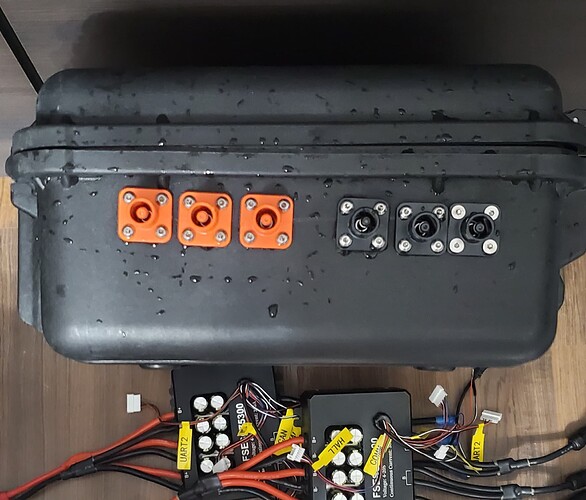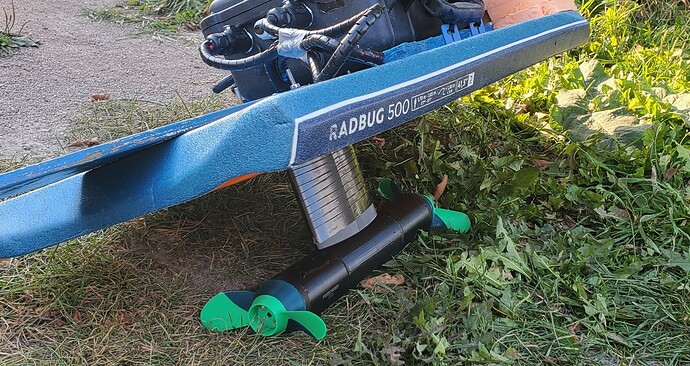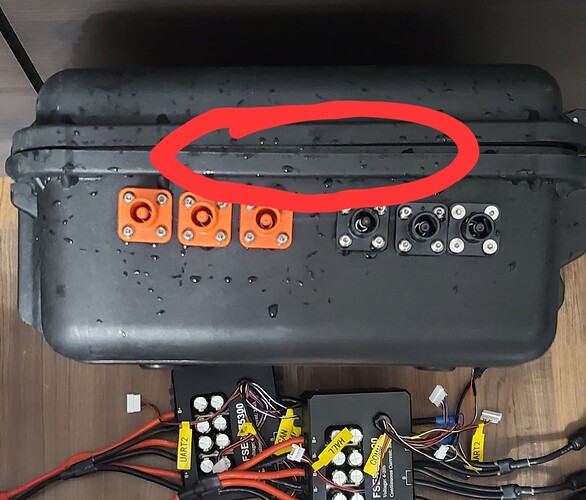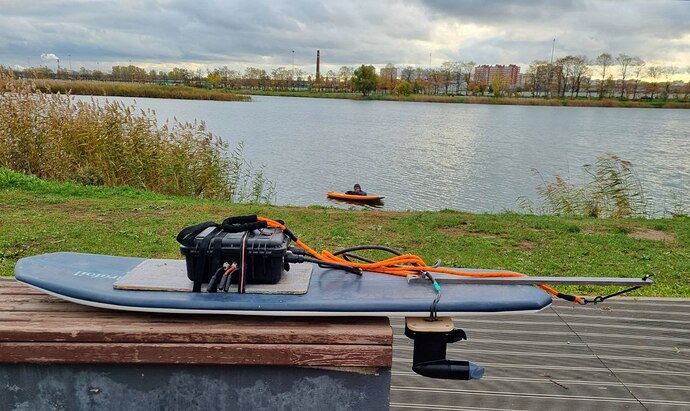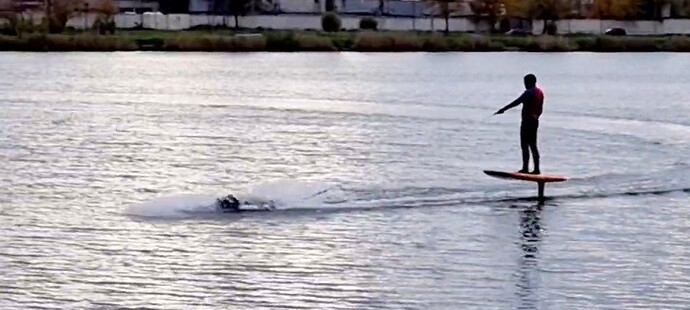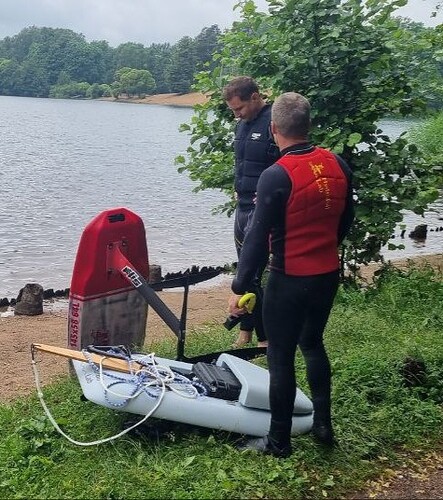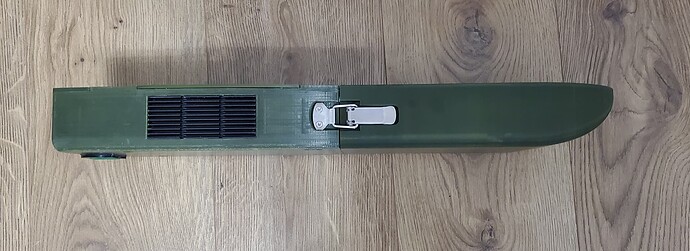I’m anticipating results on this one . Curious how the counter-rotating props will act with that amount of distance between them.
Are you doubling up on VESC’s and Batteries? What’s the final weight on this build?
The final weight, according to my calculations, will be around 25-28 kilograms. Two 75-300 controllers, two 12S batteries of 28 amp/hours each. And I changed my mind and will put it not on a bodyboard, but on a board made in the efoil mini style. The tests will be slightly delayed due to Covid , but will not be cancelled.
The Pelican is ready and tested for waterproofness, the connectors are installed in my favorite style - fast and crooked.
I really like those amphenol plugs. Can you possibly share the model and where you purchased? We’ve been having a lot of water intrusion into pelican boxes lately. We use our boogies for towing into waves and occasionally, the boogie can flip over and even though they are waterproof, the heat buildup inside causes some expansion(even with a pressure valve). Then, when the boogie flips over onto the cooler water, there’s a fast contraction, and it can suck water in through the seals. We’re extra careful now. If the boogie flips over, we turn upright as quick as possible, and check for water often. We also have our ESC’s in sealed aluminum boxes inside the Pelican box for additional protection and heatsink.
That is a wild setup!! Is it exponentially more powerful than the dual 6384’s?
What do you think about using two of these 3.5 kW 800gram 6374 back to back counter rotating:
Already waterproofed, lighter, 7kW total power. Not sure what propeller to use, foldable not necessary, I guess…
Also, are propellers disturbing each others flow or helping with nice clean flow? Please publish your 3D printing files and material settings. Thank you.
I had the same issue with water getting in the pelican. I tried a few different types as well. My theory was the same as yours, with the cooling causing contraction and sucking in water.
I tired blocking off the gore valve but it didn’t seem to help much.
A few ideas other ideas I had which could help…
-
The installed foam seal in the case could be replaced with a pourable 2 part soft silicone into the same gap. This would provide a lot better seal.
-
Water cooling of the VESC (or putting in a seperate case) would help keep the temp inside the case down.
-
Putting a bike valve on the case so you can slightly pressurise once closed so always under positive pressure.
Pelican advises to change the gasket once a year. I’m going to replace the gasket, but I will place a bead of silicone in the groove before installing it. This should give a little more height to the gasket, and more pressure against the seal.
I’m also experimenting with other boxes for other builds. PolyCase has some nice boxes that have strong latches and are very water tight. They also have clear lids that are cool looking and you can see what’s going on in the box.
I’ve been going with two boxes. One box for the VESC, and another box with quick release connectors to quickly switch out batteries without opening a Pelican box with wet hands for another session.
These are not original connectors, but Chinese copies. Here is the link.
https://aliexpress.com/item/1005005639793586.html?spm=a2g2w.orderdetail.0.0.683d4aa6HGd6Ud&sku_id=12000033846890965
As for water getting into the Pelican, the thermal conductivity of the plastic is minimal, I think this is due to the effect of water flow into the side slot. It expands and allows water to pass through. In this area. I need to test this theory using side clamps.
P.S. I mean, hot air can expand and lift the lid, but cooling will not be instantaneous due to the low thermal conductivity of the plastic.
With 63100 I feel an increase in performance. Especially looking at friends who are not as skinny as me)
I have one of these cases and it’s really well built. One way valve for pressure compensation
Edit: updated link
The project with two motors 65161 is on pause for now. I went out on the water and I didn’t really like it, in a straight line it’s excellent, there’s plenty of power, but steering with a halyard is extremely ineffective. Perhaps Ludwig’s remote control will correct the situation, I have already ordered several kits.
But, we tested a concept with two motors that can be installed on any board with a US box. And it works.
The BREmote is the key for steering! It works so good!
We made a new tow boogie. It rides and handles much better than those made on the basis of a bodyboard.
This one lokks good. Do you have any more informations? Length? Where to place the motors? …
Thank you!
The board is made in the dimensions of a bodyboard, but is much thicker. The location of the motors roughly corresponds to their location in the first photo in this thread.
Made a new version. ESC Fly Dragon 150A is now located on the side. This allowed to reduce the length to 501 centimeters with a 11s3p battery. I want to note that the controller works much better than HV3 160A or SEQURE 12200, there are no synchronization failures at high speeds. Very pleased.
Waw, really nice. Could you give us the weight of this rig ?
No rigidity issue when foiling with this 3d print box ?
Cheers
Weight with a large battery is 4.6 kilograms. I do not feel a lack of rigidity. Perhaps I am not the most sophisticated user)
